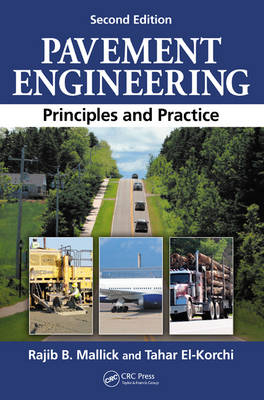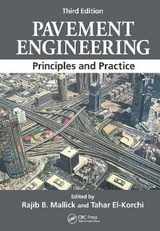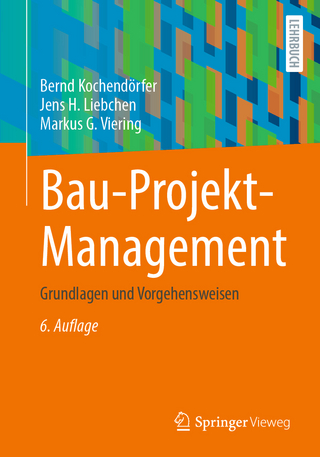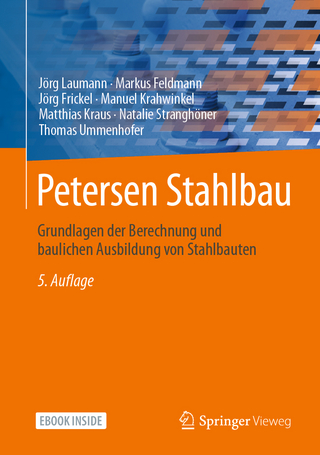
Pavement Engineering
Crc Press Inc (Verlag)
978-1-4398-7035-8 (ISBN)
- Titel erscheint in neuer Auflage
- Artikel merken
The text describes the significance of standards and examines traffic, drainage, concrete mixes, asphalt binders, distress and performance in concrete and asphalt pavements, and pavement maintenance and rehabilitation. It also contains a chapter on airport pavements and discusses nondestructive tests for pavement engineering using nuclear, deflection-based, electromagnetic, and seismic equipment. The authors explore key concepts and techniques for economic analysis and computing life-cycle cost, instrumentation for acquiring test data, and specialty applications of asphalt and concrete.
The Second Edition includes more relevant issues and recently developed techniques and guidelines for practical problems, such as selection of pavement type, effect of vehicle tires, and use of smart sensors in rollers and software for drainage analysis. This book presents in-depth, state-of-the-art knowledge in a range of relevant topics in pavement engineering, with numerous examples and figures and comprehensive references to online resources for literature and software. It provides a good understanding of construction practices essential for new engineers and materials processing and construction needed for solving numerous problems.
Dr. Rajib Mallick, PE, has extensive experience with asphalt materials, mixture design, construction, pavement design, recycling, and nondestructive testing. From 1992 to 1998, he worked as a research assistant and as a senior research associate at the National Center for Asphalt Technology (NCAT) and is currently the Ralph White Family Distinguished Professor of Civil and Environmental Engineering at Worcester Polytechnic Institute (WPI). He has completed numerous research projects for several departments of transportation, the Federal Highway Administration (FHWA), the Massachusetts Port Authority (Massport), the National Science Foundation (NSF), the Federal Aviation Administration (FAA), and several private practitioner organizations. Dr. Mallick has coauthored more than 100 papers for journals and conference proceedings, as well as several practical reports, manuals, and state-of-the-practice reports for federal, state, and local highway agencies. Dr. Tahar El-Korchi is a professor and head of civil and environmental engineering at Worcester Polytechnic Institute. He does research and teaches courses on pavement analysis, design and management, construction materials testing and evaluation, cement and concrete materials and construction processes, structural analysis and design, and high-performance structural materials at the undergraduate and graduate level. He has published more than 80 publications and presentations and has served at numerous WPI global project centers, including Puerto Rico; Washington, District of Columbia; Morocco; Costa Rica; and Panama. Dr. El-Korchi was granted the prestigious Presidential Young Investigator Award by the National Science Foundation in 1991. Dr. El-Korchi is also a consultant to several major corporations. He provides recommendations for the design and evaluation of pavements, materials, and structures.
Introduction and Description of Pavements
Importance
Functions
Design and Construction
Maintenance and Rehabilitation
Important Issues
Functional Requirements
Types and Uses of Pavements
Different Features of Typical Asphalt Pavements
Different Features of Typical Concrete Pavements
Research on Pavements
Questions
Principles of Mix and Structural Design and Construction of Asphalt Pavement
Overview
Traffic and Load Distribution Concept
Materials and Layers
Environment
Mix Design
Structural Design
Link between Mix and Structural Design
Theoretical Considerations for Structural Design
Principles of Good Construction
Putting Everything Together
Questions
Principles of Structural Design, Mix Design, and Construction of Concrete Pavements
Overview
Structural Design
Theoretical Considerations
Computer Programs for Rigid Pavements
Combined Stresses
Stresses due to Friction
Joint Opening
Joints
Concrete Properties and Mix Design
Questions
Standards
Importance of Standards
The American Society of Testing and Materials
The American Society of State Highway and Transportation Officials
Use of Standards in Materials Selection, Mix Design, and Structural Design
Use of Standards in Quality Control in Construction
Important Specifications
Questions
Traffic
Different Types of Highway Traffic
Measurement of Traffic Loads
Load Equivalency Factor and Equivalent Single-Axle Load
Alternative Load Equivalent Factor Concept
Equivalent Single-Wheel Load
Truck Tire Pressure
Truck Speed
Aircraft Loading, Gear Configuration, and Tire Pressure
Questions
Drainage
Source and Effect of Water
Estimating Flow
Hydroplaning and Surface Drainage System
Inlets
Subsurface Drainage System
Design of Subsurface Drainage Structures
Consideration of Drainage in Pavement Design
Pumping in Rigid Pavements
Use of Software for Design of Drainage Structures
Questions
Soil
Overview
Soils in Subgrade
Mass–Volume Relationships
Grain Size Distribution: Gradation
Effect of Water
Soil Classification
Density and Optimum Moisture Content
Hydraulic Conductivity
Frost Susceptibility
Swell Potential
Stiffness and Strength of Soils
Subgrade Soil Tests for Rigid Pavements
Subbase and Unstabilized Base
Soil Stabilization Concepts and Methods: Chemical and Mechanical
Dust Control
Questions
Aggregates for Asphalt and Concrete Mixes
Definition, Parent Rock, and Types
Suitability for Application
Production
Overview of Desirable Properties
Gradation for Asphalt Pavements
Specific Gravities and Absorption
Cleanliness and Deleterious Materials
Toughness or Resistance against Abrasion Loss
Particle Shape and Surface Texture
Durability/Soundness
Expansive Characteristics
Polishing and Frictional Characteristics
Aggregate Tests Specifically for Concrete
Automated Aggregate Analysis (AASHTO TP81 and PP64)
Artificial Aggregates
Questions
Asphalt and Emulsions
Asphalt Binder
Naturally Occurring Asphalts
Refined Asphalt from Crude Oil
Safe Delivery, Storage, and Handling of Asphalts
Asphalt Binder Properties
Asphalt Binder Properties and Pavement Distress and Performance
Stiffness
Viscoelastic Nature of Asphalt and Direct Measurement of Stiffness
Tensile Behavior
Superpave (Superior Performing Asphalt Pavements)
Recovery of Asphalt Binder from Asphalt Mix
Adhesion Properties
Asphalt Emulsions
Questions
Concrete Fundamentals for Rigid Pavements
Concrete
Aggregates
Cement
Water
Hydration
Steel in Concrete
Questions
Distress and Performance
Distresses in Asphalt Pavements
Distresses in Concrete Pavements
Consideration of Performance
Damage
Forensic Investigation for Determination of Type and Cause of Distress
Questions
Consideration of Major Distress Mechanisms and Material Characterization for Asphalt Pavements
Fatigue Cracking
Thermal Cracking
Rutting or Permanent Deformation
Smoothness Consideration
Top-Down Cracking
Questions
Distress Models and Material Characterization for Concrete Pavements
Distresses and Models
Tests for Concrete
Questions
Mix and Structural Design of Asphalt Mix Layers
Physical and Volumetric Properties of Asphalt Mix
Mix Design Methods
Structural Design
Questions
Mix Design and Structural Design for Concrete Pavements
Mix Design
Structural Design
Questions
Construction of Asphalt Pavements
Overview
Description and Requirements of Components in Hot Mix Asphalt–Producing Plants
Equipment Used for Transportation, Laydown, and Compaction
Important Factors
Specifications
Preparation of Subgrade and Construction of Base and Subbase Layers
Quality Control and Quality Assurance
Construction of Longitudinal Joints
Questions
Construction of Concrete Pavements
Overview
Concrete Production
Preparation of Subgrade and Base
Presetting Reinforcements such as Dowel Bars, Tiebars, and Continuous Reinforcement
PCC Slab Construction
Finishing
Curing
Paving in Hot and Cold Weather Conditions
Jointing
HIPERPAV Software
Joint Sealing
Questions
Maintenance and Rehabilitation of Pavements: Pavement Management Systems
Overview
Steps in PMS
Different PMS Approaches
Distress Survey
Maintenance and Rehabilitation of Asphalt Pavements
Maintenance and Rehabilitation of Concrete Pavements
Warranty Projects
Questions
Airport Pavements
Types, Importance, and Specifications
Structural Design of Airport Asphalt Mix Pavements
Design of Concrete Pavements
Design for Airport Pavements with Light Aircrafts
Advanced Design Methods
Nondestructive Testing and Rehabilitation of Airfield Pavements
ACN-PCN
Rehabilitation of PCC Airport Pavements
Construction Quality Control and Acceptance Testing
Constructing, Checking, and Improving Friction/Skid Resistance Drainage of Runways
Asphalt Mixes for Airport Pavement
Maintenance of Airport Pavements
Questions
Nondestructive Tests
Nuclear Gage
Falling Weight Deflectometer
Portable Falling Weight Deflectometer
Rolling Wheel Deflectometer
GeoGauge (Soil Stiffness Gauge) for Soil Compaction
Ground-Penetrating Radar
Portable Seismic Pavement Analyzer
Free Free Resonant Column Test
Ultrasonic Test
Magnetic Induction Tomography
Question
Economic Analysis and Cost-Saving Concepts
Economic Analysis
Cost-Saving Concepts
Questions
Instrumentation in Asphalt and Concrete Pavement
Temperature
Soil Moisture Content
Frost Depth
Strain in Asphalt or Concrete Pavement and Soil Layers
Stress in Soil Layers
Deflection in Layers
Data Acquisition Systems
Questions
Specialty Applications
Asphalt Mixtures
Concrete Whitetopping
Questions
Sustainable Pavement Engineering
Need for Pavements
First Consideration
Design of Layout of Pavements
Construction of Pavements
Use of Waste and Byproducts in Pavements
Workers
Pavement–Building–Nature–Symbiosis
Regulatory Bodies and Impetus for Sustainability
Human Factor
Questions
Environmental Mitigation in Transportation Projects
How Transportation Impacts the Environment
Model for Assessing Impacts and Developing Mitigation Measures
Project Conception
Impact Assessment
Alternatives Analysis
Public Involvement and Review
Enforcement and Post-Project Monitoring
Transportation Planning and Regional Mitigation Approaches
Questions
Conversion Factors
References and Bibliography
Index
| Erscheint lt. Verlag | 24.4.2013 |
|---|---|
| Zusatzinfo | 431 equations; 110 Tables, black and white; 449 Illustrations, black and white |
| Verlagsort | Bosa Roca |
| Sprache | englisch |
| Maße | 178 x 254 mm |
| Gewicht | 1452 g |
| Themenwelt | Technik ► Bauwesen |
| ISBN-10 | 1-4398-7035-7 / 1439870357 |
| ISBN-13 | 978-1-4398-7035-8 / 9781439870358 |
| Zustand | Neuware |
| Informationen gemäß Produktsicherheitsverordnung (GPSR) | |
| Haben Sie eine Frage zum Produkt? |
aus dem Bereich



